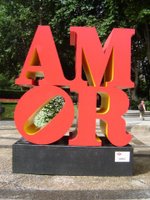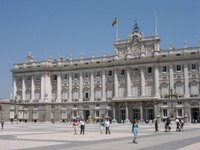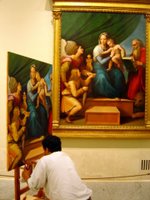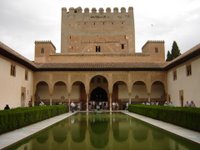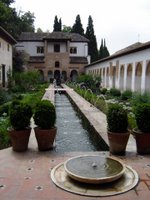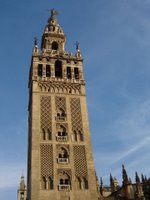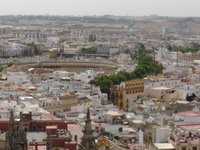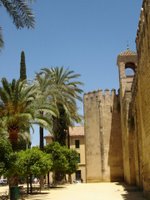Amor on the Paseo del Prado
The last stop on the Spanish agenda was Madrid - the capital, and almost bang smack in the centre of the country, on the plains known as the meseta. Madrid is a fairly large city, around 3.5 million or so, and originally was made the capital, as the King at the time feared the power of the church in Toledo, which was the more obvious choice for a capital.Left: Palacio Real, Madrid. Right: Palacio Real, Aranjuez
Lavender in bloom in Aranjuez
During the time we had in Madrid, we visited the Palacio Real, an ornate Royal Palace, the Palacio Real and gardens of Aranjuez. There is a piece of music, Concierto de Aranjuez by Rodrigo which I have always enjoyed, and I was pleased that visiting the place gave me the same feeling as the music, a place of calm and retreat. We hardly saw another soul while we were there (admittedly during siesta time).
Posing with the suit of Armour at Toledo's railway station, and Puente del Alcántara
We also visited Toledo, which is known as the Imperial City. You see much of the Moorish influence in Toledo, while at the same time, a city recognisable by the Vatican as the seat of the church in Spain. The cathedral in Toledo has a great collection of artworks, particularly by El Greco as well as many other treasures. We also visited the famous El Greco work, El Entierro del Conde de Orgaz (The Burial of the Count of Orgaz) in the Iglesia de Santo Tomé and the Mezquita de Cristo de la Luz, a mosque that was later converted into a church with some nice frescos. We finished our trip to Toledo waiting in one of the most impressive railway stations I've been to (even compared to the Russian metro!!).
Interior of the railway station - tiling and stained glass windows
Back in Madrid, we visited the Monasterio de la Dezcartas, sponsored by a rich Austrian and her friends at the time of the Habsburgs in Spain where I managed to understand much of the Spanish language tour, surprisingly. I also had some time to visit the Museo del Prado, a world class museum of art (which has, as one of the highlights, Velazquez's Las Meninas. While we were in Barcelona, we got to see Picasso's work of the same name).
I think that our already late eating times got later still in Madrid... Nothing like waiting till 10 or 11pm for dinner... and on one night, we even followed with late night churros and chocolate, a Madrid must. Yum!
Late night churros and chocolate at the Chocolatería San Ginés,
and an artist replicating the works of the Museo del Prado
